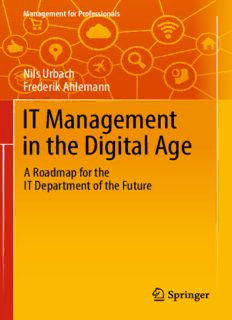
IT Management in the Digital Age: A Roadmap for the IT Department of the Future PDF
Preview IT Management in the Digital Age: A Roadmap for the IT Department of the Future
Management for Professionals Nils Urbach Frederik Ahlemann IT Management in the Digital Age A Roadmap for the IT Department of the Future Management for Professionals Moreinformationaboutthisseriesathttp://www.springer.com/series/10101 (cid:129) Nils Urbach Frederik Ahlemann IT Management in the Digital Age A Roadmap for the IT Department of the Future NilsUrbach FrederikAhlemann UniversityofBayreuth UniversityofDuisburg-Essen Bayreuth,Germany Essen,Germany ISSN2192-8096 ISSN2192-810X (electronic) ManagementforProfessionals ISBN978-3-319-96186-6 ISBN978-3-319-96187-3 (eBook) https://doi.org/10.1007/978-3-319-96187-3 LibraryofCongressControlNumber:2018951417 #SpringerInternationalPublishingAG,partofSpringerNature2019 Thisworkissubjecttocopyright.AllrightsarereservedbythePublisher,whetherthewholeorpart of the material is concerned, specifically the rights of translation, reprinting, reuse of illustrations, recitation,broadcasting,reproductiononmicrofilmsorinanyotherphysicalway,andtransmissionor informationstorageandretrieval,electronicadaptation,computersoftware,orbysimilarordissimilar methodologynowknownorhereafterdeveloped. The use of general descriptive names, registered names, trademarks, service marks, etc. in this publication does not imply, even in the absence of a specific statement, that such names are exempt fromtherelevantprotectivelawsandregulationsandthereforefreeforgeneraluse. Thepublisher,theauthorsandtheeditorsaresafetoassumethattheadviceandinformationinthisbook arebelievedtobetrueandaccurateatthedateofpublication.Neitherthepublishernortheauthorsorthe editorsgiveawarranty,expressorimplied,withrespecttothematerialcontainedhereinorforanyerrors oromissionsthatmayhavebeenmade.Thepublisherremainsneutralwithregardtojurisdictionalclaims inpublishedmapsandinstitutionalaffiliations. ThisSpringerimprintispublishedbytheregisteredcompanySpringerNatureSwitzerlandAG Theregisteredcompanyaddressis:Gewerbestrasse11,6330Cham,Switzerland Testimonials Digitalizationhasfar-reachingconsequencesfortoday’scompanies.Itisnotonlyan option anymore, but a necessity—especially for their IT departments. This book showswhatITmanagersneedtobepreparedfor.Particularlyworthreading. MarkusBentele VicePresidentInformationTechnology/GroupCIO,MAHLEInternationalGmbH AcompulsoryreadforCEOsandCIOsalike.Thisbookillustratesthestrategicand entrepreneurial importance of IT in an excellent and easily digestible way. CIOs receive very good support in focusing on the important and relevant topics of IT transformation.Enjoyreadingandimplementing. BernhardKoch ViceChairmanoftheExecutiveBoard,GFFTe.V. ThisbookdemonstratestheimpactofdigitaltransformationonITorganizationsand theirmanagement.Italsopresentspotentialrisksfortechnologyavailability,security, anddataprotection.TheauthorsdevelopavisionofwhatITmanagementshouldlook likein10yearsifitistocontinueplayinganimportantroleinthecompany.Thebook seekstomotivateITexecutivesandmanagerswithITresponsibilitytoactivelyadapt their thinking and their IT organizations before they are forced to react to external pressure.Definitelyworthreading! SvenKreimendahl DirectorBusinessTechnologyServices,Campana&Schott Thebookgivesacomprehensiveandwell-positionedoverviewofthevariousfacets of digitalization. With the presented hypotheses and their direct formulation, the authorspolarizeverystrongly,wherebythereaderhimselfcomparestheoldwiththe newworldandisforcedtotakeastand.AstheresponsiblepersonintheITarea,itis difficulttoevadethis.Thisbookissuitableforbothcommencingwithandreflecting onowndigitalizationinitiatives,andIrecommendthatitshouldbereadurgently! Dr.BenediktMartens SeniorProjectManager,EvonikIndustriesAG v vi Testimonials ThepartiallyradicalhypothesesaddressthecurrentandfuturechallengesofITina corporategroupextremelyaccurately.Withthefuture“innovate-design-transform” model, the authors describe modern collaboration models of IT and business, together with innovative partnerships, in a comprehensible and practice-relevant way. Dr.KianMossanen ChiefInformationOfficer,DRÄXLMAIERGroup Forme,digitalizationmeansautomationandnewbusinessmodels.ITdepartments were always involved with automation, but new business models are partly an existentialchallengeforcompaniesandtheirITdepartments.Thisbookcomprehen- sivelyshowswhatthisentailsfortoday’sITdepartmentsandmanagers. MichaelNeff FormerCIO,RWEAG Intimesofrapid—alsotechnological—changes,agilityisrequired. ThatiswhyIT mustberestructuredwithinthecompanyandwhyoldparadigmsmustbeabandoned. Intheirbook,theauthorsimpressivelyshowwhatneedstobeconsidered.Frommy pointofview,amustreadforCIOs,butalsoforCEOsandCDOs. BurkhardSchütte RetiredPartnerandFormerChiefInformationOfficer,PricewaterhouseCoopersAG Driven by digitalization, IT departments will undergo significant change in the coming years. This book shows in which direction the journey is heading. RecommendedreadingforeveryonewhoisresponsibleforITincompaniesorwho wantstopreparefordigitalization. Dr.RolandSchütz ChiefInformationOfficer,DeutscheLufthansaAG The book provides informative insights into IT management in times of digitaliza- tion. On the basis of ten hypotheses, the two authors take a differentiated look at digital transformation and show which changes are associated with this process in the company. The recommendations derived from this give IT managers helpful suggestionsforatechnicallysounddiscussionofthetopic. ThomasUllrich BoardMember,DZBANKAG Foreword Digital transformation is the megatrend of our time, heatedly discussed not just in Germanybutallaroundtheworld.Afterall,itbringscountlesschangeswithitand as many new challenges as opportunities. That might not sound especially sensa- tionalatfirst.Afterall,corporateITdepartmentshavedealtwithconstantchangefor years—not only new applications and technologies, but even comprehensive approaches like outsourcing and cloud computing. One major difference to earlier developmentsstandsout,however;thedigitalrevolutionisarisingfrommanynew technologies at once, among them big data analytics, social media, cognitive services,mobilecomputing,theInternetofThings,artificialintelligence,andvirtual andaugmentedreality—toonlynameafewofthemostimportant. For companies, this means carrying out countless projects for development, innovation, and strategy—all despite often only having a vague idea of the end goal. The way forward is often unclear. That overwhelms most traditional IT departments.Theyareaccustomedtodrawingupplansfromrequirementsmanage- ment and providing specialist departments with changes according to detailed releaseplansandthewaterfallmethod.Butthatdoesnotcutitanymore.Thefuture ofITwillonlyfunctionwiththenecessaryefficiencywhenitscommodityservices are highly standardized—such as with electric sockets. Just as energy providers supply electricity, standardized interfaces from cloud providers will offer what we stillcall“officeIT.”Whatoncewas“owned”willsoonbesimply“used.”Thefuture certainlystillhasroomforimprovement.Wecanimagine,forinstance,akindofIT stockexchangeforcommodityservices. Even today, in fact, companies with their own development department for standardized platforms and IT services have practically dwindled from existence. Outsourcing may increase efficiency, but it has yet to exhaust its competitive advantages. Standardized platforms and cloud services—like electricity—could be used by many other companies at once. IT departments must expand their scope frommerelyincreasingtheirproductivityandactivelyparticipateinvaluecreation. Whatwouldthatlooklike?Wearebeginningtorealizethatactualaddedvaluecan be created by linking previously separate information and connecting multiple technologies. This is where IT management must place its center of gravity in the ageofdigitalization.ITmustemploycomprehensivebigdataanalysestoworkwith vii viii Foreword company management and specialist departments to question existing business modelsandallownewtechnologiestocontinuedevelopingorevenrestructurethem. IT management should be internally structured to increase production and crea- tivity, enabling innovation through agile methods. It should be integrated into departments and encourage new business models and markets. That includes innovations for higher added value, new opportunities in marketing and sales, creating new communication channels, and shaping the workplace of the future. This also leads to an increase in employee satisfaction. Customer experience man- agementmustalsobeestablishedtoactivelypointthewayfromasatisfiedcustomer toabrandambassador.ThisindicatesjusthowinvolvedITdepartmentsareinvalue creation. They are responsible for arming and fortifying staff against competition. They also expand their customer bases to other market segments for more growth andbusinessactivities. All told, digital transformation certainly has disruptive consequences for many companies and industries. But continuing analog business is no longer an option. Technological innovation is already an important competitive factor for business today, with a significant influence on products, services, business processes, and salesandsupplychannels. This book demonstrates the significant impact of digitalization on IT organizations and their management, as well as the risks to overcome, especially for technology availability, security, and data protection. The authors provide answers to many questions and explain what IT management should look like in 10 years if it is to continue playing an important role in the company. Their book seekstomotivateITexecutivesandmanagerswithITresponsibilitytoactivelyadapt their thinking and their IT organizations before they are forced to react to external pressure.Ifitgetstothatpoint,itmightalreadybetoolate. DirectorBusinessTechnologyServices, SvenKreimendahl Campana&Schott Cologne,Germany April2018 Preface The digitalization topic has become an integral part of political debate, economic news,aswellasinternalcompanyprojectsandcoordination.Keywordssuchasbig data, cloud computing, digital transformation, Industry 4.0, and Internet of things constantlyariseinpublicandinternalcompanydiscussions.Thereare,however,still many questions that remain unanswered, such as the implications of digitalization for individual industries, as well as the impact thereof, which IT departments in companieswillhavetoconsiderinfuture.Today’sITbosseswouldusuallyliketo claimthetopicforthemselves.Thisisnotunexpected,becausetheirdepartmentsare responsibleforinformationtechnologyincompanies,anddigitalizationpromisesto expandtheirsphereofactivity,oratleasttostrengthentheirrole. However,manyCIOsandITexecutivesencounterproblems.TheirITdepartments areoftenseenaspureserviceproviderswithnoparticularinnovationskills.Business customers—thatis,theotherdepartmentsintheirowncompany—oftenactindepen- dently of the IT department when developing IT-based business and process innovations. An example of this is a marketing department that starts big data initiativeswithoutinvolvingthein-housetechnologyexperts.Suchasituationisnot surprising,sinceITdepartmentemployeesarestillverytechnologyorientedandoften have little or no business know-how. Furthermore, creativity, entrepreneurship, and innovation activities often have merely a shadow existence in an industrialized IT department, which is focused on reliability and stability. Most IT departments are structurallyandprocedurallynotpreparedtoplayaspecialroleindigitaltransforma- tion.Forexample,theylackfunctioninginnovationmanagementprocessesoreffec- tive technology scouting. Past cost optimizations also contribute to this: their capacitiesarerarelysufficienttotestandimplementnewideasbeyonddailybusiness. Consequently, IT managers feel uncertain: How can we position ourselves in this situation?Howshouldweapproachdigitaltransformation?Wheredowebegin?What rolewillweplayinfuture? This book identifies these questions and intends to answer them from a specific perspective.Itillustratesthedigitalizationimplicationsfortoday’sITdepartments—with theirstructures,processes,andpeople.Inparticular,thisbookdiscussesthemeaningof digitalization,itpresentsapictureofcorporateITin10–15years’time,anditillustrates howcurrentmanagerscanprepareforthisdevelopment. ix
Description: